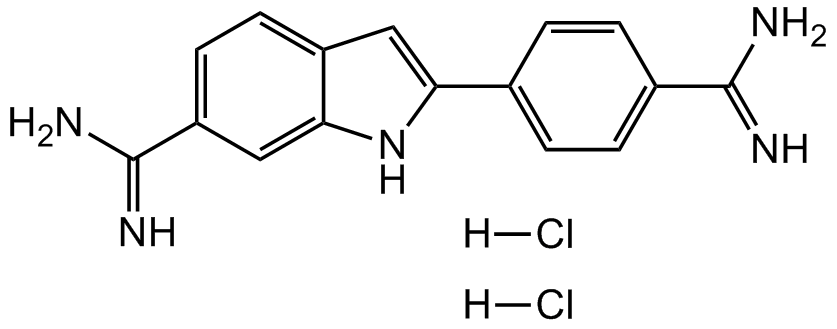DAPI . dihydrochloride
| Code | Size | Price |
|---|
| AG-CR1-3668-M005 | 5 mg | £50.00 |
Quantity:
| AG-CR1-3668-M025 | 25 mg | £150.00 |
Quantity:
| AG-CR1-3668-M100 | 100 mg | £400.00 |
Quantity:
Prices exclude any Taxes / VAT
Overview
Regulatory Status: RUO
Shipping:
Ambient
Storage:
-20°C
Images
Documents
Further Information
Alternate Names/Synonyms:
4',6-Diamidino-2-phenylindole dihydrochloride; 2-(4-Amidinophenyl)-6-indolecarbamidine dihydrochloride; FxCycle Violet
Appearance:
Yellow solid.
CAS:
28718-90-3
EClass:
32160000
Form (Short):
liquid
Handling Advice:
Keep cool and dry.Protect from light and moisture.
Hazards:
H317, H319, H335
InChi:
InChI=1S/C16H15N5.2ClH/c17-15(18)10-3-1-9(2-4-10)13-7-11-5-6-12(16(19)20)8-14(11)21-13;;/h1-8,21H,(H3,17,18)(H3,19,20);2*1H
InChiKey:
FPNZBYLXNYPRLR-UHFFFAOYSA-N
Long Description:
Chemical. CAS: 28718-90-3. Formula: C16H15N5 . 2HCl. MW: 277.3 . 72.9. Synthetic. Cell permeable fluorescent DNA stain. AT-sequence-specific DNA intercalator. Binds to the minor groove of double-stranded DNA (preferentially to adenine and thymine (AT) rich DNA), like Hoechst dyes, forming a stable complex which fluoresces approximately 20 times greater than DAPI alone. Spectral Data: Excitation: lambdaex 340 nm; Emission: lambdaem 488 nm (only DAPI). Excitation: lambdaex 360nm; Emission: lambdaem 460nm (DAPI-DNA complex). Commonly used to stain DNA and chromosomes for fluorescent microscopy and flow cytometry applications. DAPI is often used as a counterstain, as its ultraviolet excitation (lambdaex 360nm) and blue emission (lambdaem 460nm) wavelengths separate it nicely from many popular primary fluorophores. Can be used on either fixed or live cells, although it passes through the membrane less efficiently in live cells and therefore the effectiveness of the stain is lower and demands higher concentrations to be used. Reversible inhibitor of S-adenosyl-L-methionine decarboxylase and KAO (diamine oxidase).
MDL:
MFCD00012681
Molecular Formula:
C16H15N5 . 2HCl
Molecular Weight:
277.3 . 72.9
Package Type:
Plastic Vial
Precautions:
P302, P352, P304, P340, P305, P351, P338
Product Description:
Cell permeable fluorescent DNA stain. AT-sequence-specific DNA intercalator. Binds to the minor groove of double-stranded DNA (preferentially to adenine and thymine (AT) rich DNA), like Hoechst dyes, forming a stable complex which fluoresces approximately 20 times greater than DAPI alone. Spectral Data: Excitation: lambdaex 340 nm; Emission: lambdaem 488 nm (only DAPI). Excitation: lambdaex 360nm; Emission: lambdaem 460nm (DAPI-DNA complex). Commonly used to stain DNA and chromosomes for fluorescent microscopy and flow cytometry applications. DAPI is often used as a counterstain, as its ultraviolet excitation (lambdaex 360nm) and blue emission (lambdaem 460nm) wavelengths separate it nicely from many popular primary fluorophores. Can be used on either fixed or live cells, although it passes through the membrane less efficiently in live cells and therefore the effectiveness of the stain is lower and demands higher concentrations to be used. Reversible inhibitor of S-adenosyl-L-methionine decarboxylase and KAO (diamine oxidase).
Purity:
>97% (HPLC)
Signal word:
Warning
SMILES:
[H]Cl.[H]Cl.NC(C1=CC=C2C(NC(C3=CC=C(C(N)=N)C=C3)=C2)=C1)=N
Solubility Chemicals:
Soluble in water (10mg/ml). May require heating and sonication. Slightly soluble in DMSO, ethanol, methanol or PBS.
Transportation:
Non-hazardous
UNSPSC Category:
Fluorescent Reagents
UNSPSC Number:
41105331
Use & Stability:
Stable for at least 2 years after receipt when stored at -20°C. Store solutions at -20°C in the dark.
References
A simple cytochemical technique for demonstration of DNA in cells infected with mycoplasmas and viruses: W.C. Russell, et al.; Nature 253, 461 (1975) | DIPI and DAPI: fluorescence banding with only negliglible fading: W. Schnedl, et al.; Hum. Genet. 36, 167 (1977) | An evaluation of DNA fluorochromes, staining techniques, and analysis for flow cytometry. I. Unperturbed cell populations: I.W. Taylor & B.K. Milthorpe; J. Histochem. Cytochem. 28, 1224 (1980) | A comparative study of DAPI, DIPI, and Hoechst 33258 and 33342 as chromosomal DNA stains: F. Otto & K.C. Tsou; Stain Technol. 60, 7 (1985) | Estimation of total DNA in crude extracts of plant leaf tissue using 4',6-diamidino-2-phenylindole (DAPI) fluorometry: L.S. Lee & H.M. Garnett; J. Biochem. Biophys. Methods 26, 249 (1993) | 4',6-Diamidino 2-phenylindole is a new reversible inhibitor of diamine oxidase and S-adenosyl-L-methionine decarboxylase from mammalian tissues: C. Cubria, et al.; Comp. Biochem. Physiol. C. 105, 251 (1994) | Flow cytometric detection of apoptosis: comparison of the assays of in situ DNA degradation and chromatin changes: M.A. Hotz, et al.; Cytometry 15, 237 (1994) | DAPI: a DNA-specific fluorescent probe: J. Kapuscinski; Biotech. Histochem. 70, 220 (1995) | The use of DAPI as a replacement for ethidium bromide in forensic DNA analysis: E. Buel & M. Schwartz; J. Forensic Sci. 40, 275 (1995) | Visualizing chromatin and chromosomes in living cells: D. Zink, et al.; Methods: A Companion to Methods in Enzymology 29, 42 (2003) | Propidium Iodide (PI) or DAPI Staining of Unfixed Solid Tissues for Flow Cytometry: L. Rodgers; CSH Protoc. 2006, pdb.prot4438 (2006) | DAPI Staining of Drosophila Embryos: W.F. Rothwell & W. Sullivan; CSH Protoc. 2007, pdb.prot4834 (2007) | Labeling nuclear DNA using DAPI: B. Chazotte; CSH Protoc. 2011, pdb.prot5556 (2011) | An investigation of the photophysical properties of minor groove bound and intercalated DAPI through quantum-mechanical and spectroscopic tools: A. Biancardi, et al.; Phys. Chem. Chem. Phys. 15, 4596 (2013) | DAPI staining and fluorescence microscopy techniques for phytoplasmas: N.M. Andrade & N.L. Arismendi; Methods Mol. Biol. 938, 115 (2013) | The hazards of DAPI photoconversion: effects of dye, mounting media and fixative, and how to minimize the problem: M. Jez, et al.; Histochem. Cell Biol. 139, 195 (2013) | Fluorescence lifetime imaging of DAPI-stained nuclei as a novel diagnostic tool for the detection and classification of B-cell chronic lymphocytic leukemia: G. Yahav, et al.; Cytometry A 89, 644 (2016)
Related Products
| Product Name | Product Code | Supplier |
|---|



